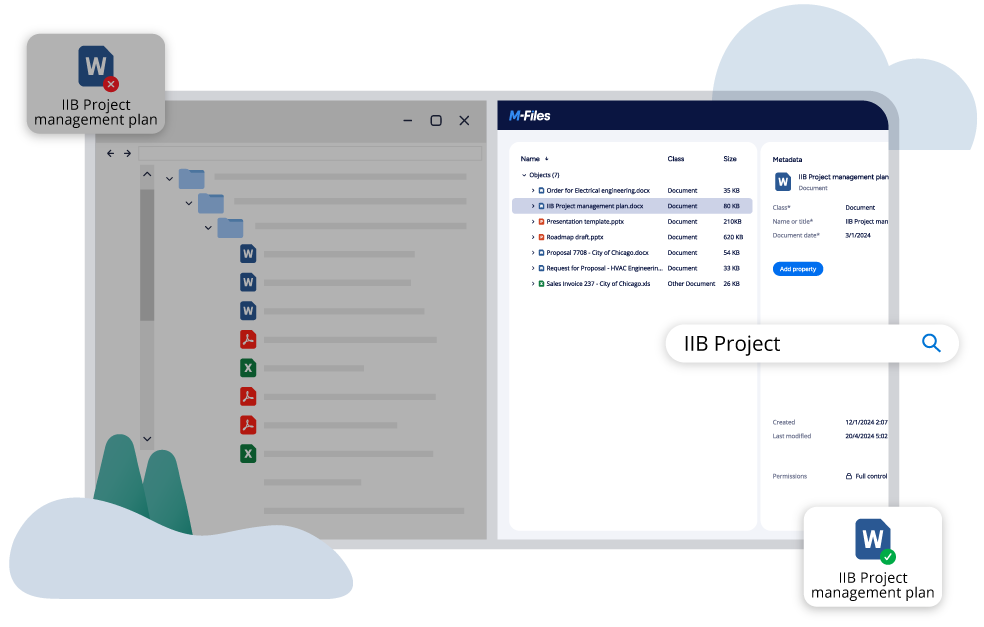The Ultimate Guide to Document Management Systems (DMS)
Modern businesses run on documents: proposals, contracts, reports, invoices, and more. Managing those documents manually or across disconnected systems creates risk, slows work down, and makes it harder to stay compliant.
A Document Management System (DMS) helps you organize, secure, and automate the flow of documents throughout your organization. This guide answers the key questions people ask when evaluating, deploying, or optimizing a DMS. Each section gives you a concise overview and points you to a full article for deeper exploration.

Explore the Guide
What Is a Document Management System and Why Do Businesses Need One?

A DMS is software that stores, organizes, and manages digital documents and related information. Instead of keeping files in shared drives, inboxes, or filing cabinets, a DMS centralizes everything in one place.
The benefits go beyond storage. A DMS helps businesses:
- Search documents by metadata or content
- Control access and track activity
- Manage document versions and approvals
- Reduce paperwork and manual tasks
- Support compliance and audit readiness
Whether you’re in healthcare, finance, construction, or any industry that handles large volumes of documents, a DMS can streamline operations and reduce risk.
Read more: What Is a Document Management System and Why Do Businesses Need One?
How Do You Choose the Right DMS for Your Organization?
Choosing the right DMS depends on your goals, size, budget, and technical environment. A well-matched DMS should support how your team works and grows with your business.
Key decision factors include:
- Ease of use and employee adoption
- Integration with CRM, ERP, or Microsoft 365
- Security and access control features
- Cloud versus on-premises deployment
- Licensing model, cost, and hidden fees
- Migration support and vendor onboarding
Implementation time and training needs also matter. Some systems are quick to roll out and user-friendly. Others require more IT resources. A strong DMS partner will walk you through setup, provide training materials, and offer ongoing support.

What Security and Compliance Features Should a DMS Include?

Protecting sensitive documents is one of the most important roles of a DMS. A good system keeps information safe and supports your regulatory obligations.
Look for these features:
- Role-based access control and permission management
- Audit trails that track every document action
- Encryption of files at rest and in transit
- Retention policies that align with regulations
- Support for legal holds and document recovery
These tools help businesses comply with standards like HIPAA, GDPR, FINRA, and others. They also reduce the risk of unauthorized access or accidental loss.
Explore: Security, Compliance, and Regulations in Document Management
Should You Choose a Cloud-Based or On-Premises DMS?
Both models offer advantages, but cloud-based DMS platforms are now the default choice for most organizations.
Cloud DMS benefits:
- Access from anywhere on any device
- Faster setup and lower upfront cost
- Automatic updates and reduced IT workload
- Built-in scalability as your business grows
- Strong vendor-level security and data backups
On-premises DMS benefits:
- More control over infrastructure and data
- Preferred in highly regulated or restricted environments
The right choice depends on your industry, data sensitivity, and IT resources. For most organizations, cloud offers the best balance of security, convenience, and cost.

How Does Workflow Automation Work in a DMS?

A modern DMS does more than store documents—it also automates the processes around them. Workflow automation ensures that documents move to the right people at the right time.
With automated workflows, you can:
- Route invoices or contracts for approval automatically
- Notify users when action is required
- Track document status in real time
- Eliminate repetitive manual handoffs
- Standardize processes for HR, finance, legal, and more
Some systems also support e-signatures, custom form fields, and AI-assisted routing. Automation saves time, reduces errors, and helps enforce policy.
Learn more: Workflow Automation and Advanced Functionality
How Does a DMS Improve Collaboration and Productivity?
A DMS helps teams collaborate more effectively, especially in distributed or hybrid work environments. It brings structure and transparency to document-heavy workflows.
Key benefits include:
- Real-time document access for multiple users
- Clear version history and edit tracking
- Reduced reliance on email attachments
- Mobile access for remote and field teams
- Secure internal and external file sharing
- Integration with Microsoft Office, Teams, and more
You also gain powerful search tools that use metadata and document content to find what you need quickly. This saves time, reduces duplication, and improves decision making.

What Challenges Should You Plan for When Deploying a DMS?

Even the best system can cause problems if poorly planned. Avoid these common pitfalls:
- Lack of internal buy-in or executive sponsorship
- Confusing workflows or inconsistent naming conventions
- Weak training that leaves users frustrated
- Underestimating data migration complexity
- Choosing a system with poor support
A successful rollout includes a change management plan, stakeholder alignment, and strong onboarding resources. Make sure you have help from your vendor during setup and beyond.
What Features Matter Most in a DMS?
Not all document management features are created equal. Focus on the capabilities that deliver real business value.
Top features to consider:
- Metadata and intelligent document tagging
- Version control and collaboration history
- Real-time document status tracking
- Document retention and lifecycle management
- Duplicate detection and cleanup tools
- Role-based access and audit logs
Advanced platforms may also include AI tools, content analytics, and integrations with broader enterprise systems like ECM platforms.
Explore: Exploring DMS Features: Metadata, Versioning, and Beyond

How Do You Measure DMS ROI and Make It Last?

A good DMS investment should pay off in efficiency, security, and reduced overhead. But ROI is not just about cost savings. It also includes speed, compliance, and user satisfaction.
Ways to track ROI:
- Time saved finding and processing documents
- Fewer lost files and compliance incidents
- Reduced printing, copying, and storage costs
- Higher team productivity and engagement
- Shorter contract approval cycles
Advanced platforms may also include AI tools, content analytics, and integrations with broader enterprise systems like ECM platforms.






